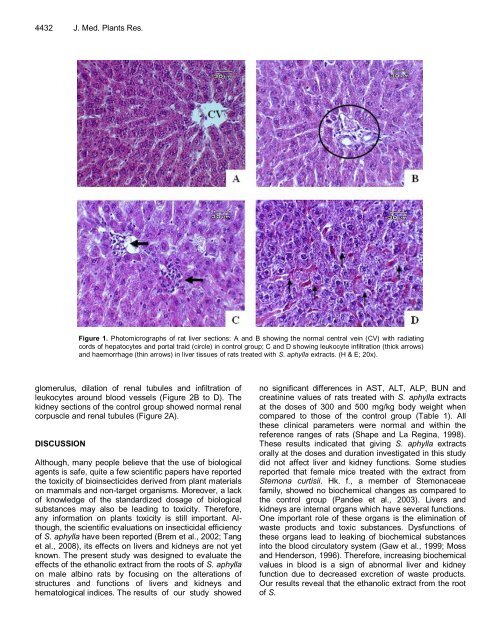Download Complete Issue (4740kb) - Academic Journals
Download Complete Issue (4740kb) - Academic Journals
Download Complete Issue (4740kb) - Academic Journals
Create successful ePaper yourself
Turn your PDF publications into a flip-book with our unique Google optimized e-Paper software.
4432 J. Med. Plants Res.<br />
Figure 1. Photomicrographs of rat liver sections: A and B showing the normal central vein (CV) with radiating<br />
cords of hepatocytes and portal traid (circle) in control group; C and D showing leukocyte infiltration (thick arrows)<br />
and haemorrhage (thin arrows) in liver tissues of rats treated with S. aphylla extracts. (H & E; 20x).<br />
glomerulus, dilation of renal tubules and infiltration of<br />
leukocytes around blood vessels (Figure 2B to D). The<br />
kidney sections of the control group showed normal renal<br />
corpuscle and renal tubules (Figure 2A).<br />
DISCUSSION<br />
Although, many people believe that the use of biological<br />
agents is safe, quite a few scientific papers have reported<br />
the toxicity of bioinsecticides derived from plant materials<br />
on mammals and non-target organisms. Moreover, a lack<br />
of knowledge of the standardized dosage of biological<br />
substances may also be leading to toxicity. Therefore,<br />
any information on plants toxicity is still important. Although,<br />
the scientific evaluations on insecticidal efficiency<br />
of S. aphylla have been reported (Brem et al., 2002; Tang<br />
et al., 2008), its effects on livers and kidneys are not yet<br />
known. The present study was designed to evaluate the<br />
effects of the ethanolic extract from the roots of S. aphylla<br />
on male albino rats by focusing on the alterations of<br />
structures and functions of livers and kidneys and<br />
hematological indices. The results of our study showed<br />
no significant differences in AST, ALT, ALP, BUN and<br />
creatinine values of rats treated with S. aphylla extracts<br />
at the doses of 300 and 500 mg/kg body weight when<br />
compared to those of the control group (Table 1). All<br />
these clinical parameters were normal and within the<br />
reference ranges of rats (Shape and La Regina, 1998).<br />
These results indicated that giving S. aphylla extracts<br />
orally at the doses and duration investigated in this study<br />
did not affect liver and kidney functions. Some studies<br />
reported that female mice treated with the extract from<br />
Stemona curtisii. Hk. f., a member of Stemonaceae<br />
family, showed no biochemical changes as compared to<br />
the control group (Pandee et al., 2003). Livers and<br />
kidneys are internal organs which have several functions.<br />
One important role of these organs is the elimination of<br />
waste products and toxic substances. Dysfunctions of<br />
these organs lead to leaking of biochemical substances<br />
into the blood circulatory system (Gaw et al., 1999; Moss<br />
and Henderson, 1996). Therefore, increasing biochemical<br />
values in blood is a sign of abnormal liver and kidney<br />
function due to decreased excretion of waste products.<br />
Our results reveal that the ethanolic extract from the root<br />
of S.

















